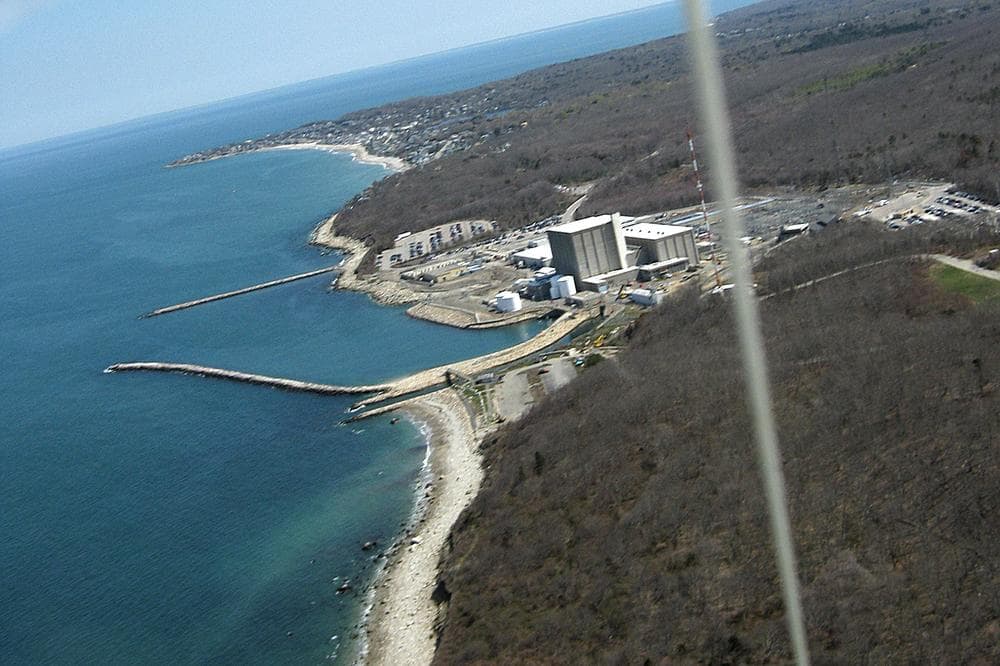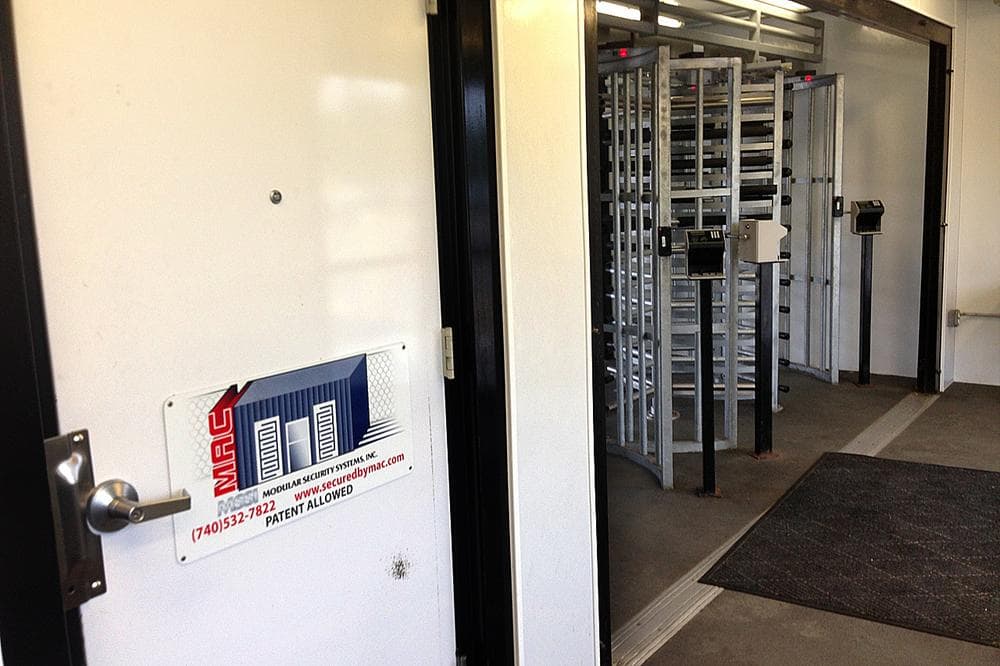Advertisement
Residents Challenge Pilgrim's Permit For New Nuclear Waste Site
ResumeUpdate 7/11: Wednesday night, the Plymouth zoning board voted to reject the opponents appeal, clearing the way for Pilgrim to continue construction on the new waste site.

PLYMOUTH, Mass. — Since 1972, the Pilgrim Nuclear Power Plant here has generated prodigious amounts of electricity, tons of radioactive waste and plenty of controversy.
Wednesday night, the debate heats up as the Plymouth zoning board votes on whether to allow Entergy — the plant's owner — to continue with construction on a new waste storage site. The vote could stall or even stop the nuclear power plant for good.
Security, And Public Scrutiny
A few weeks ago, anti-nuclear activists — with the help from the law firm EcoLaw — flew a kite with a camera over the plant. They wanted to see what Entergy was building on the 1,600-acre site along Cape Cod Bay.
"This is the first time in a long time that citizens have pulled back the blanket of secrecy that has allowed Entergy to operate without much public scrutiny on the local level," said attorney Meg Sheehan, who was born and raised in Plymouth.
Pilgrim is surrounded by double chain link fences, razor wire, motion detectors and 30-foot guard posts.

If you want to get inside to see firsthand what the kite camera saw, you need special permission. You must agree in advance that any photos you take are cleared by the head of security. And, like all visitors, you must pass a series of checkpoints.
Security has always been tight at our nation's nuclear power plants, but since 9/11 there are new procedures and anti-terrorist defenses — some hidden, some in plain view. There are biometric devices that scan your hand, explosive-sniffing machines and super sensitive metal detectors. It's like airport security but a lot tougher.
"The idea of our security is delay," said David Tarantino, Entergy's communications manager. "We have to prove to the [Nuclear Regulatory Commission] that we are capable of defending this place from armed attackers with evil intent, and they have insider help. And to test that we actually have exercises where we bring in retired [Navy] SEALs and they scout the place around and they try to actually storm the place."
Tarantino says the closest the SEALs have reached is the turbine building, never the reactor.
All the security measures — the mock attacks and multiple checkpoints — are designed to protect the building where we are not allowed to go. It houses the heart of the plant — the nuclear reactor. The reactor core contains the radioactive assemblies that make the steam that turn the turbines and generate 14 percent of the electricity produced in Massachusetts.
Pilgrim's reactor is a GE Mark 1 — the same make and model used at Fukushima, Japan, where a natural disaster two years ago led to a nuclear nightmare, a mass evacuation and the creation of an 18-mile wide exclusion zone. But Tarantino says there are important differences between Fukushima and Pilgrim.
"They had aboveground diesel tanks," he explained. "When that tsunami came in it wiped away their tanks. Our tanks are underground in waterproof containers."
But as bad as Fukushima was, the biggest fear wasn't a reactor meltdown. It was that nuclear waste pools would rupture and drain, exposing spent fuel rods that would ignite, sending a massive amount of radioactivity into the air.
Running Out Of Room
At Pilgrim — like Fukushima — spent fuel is stored in a pool high above the reactor. Tarantino says the pool contains all the nuclear waste ever produced by Pilgrim's reactor.
"We have 40 years worth of spent fuel in the reactor building," Tarantino said. "Fuel has never left the site."
But that was never the way it was supposed to be. Originally, Pilgrim's spent fuel pool — just 30 feet wide, 40 feet long and 40 feet deep — was designed to temporarily hold about 900 spent fuel assemblies. Today, the waste pool at Pilgrim holds nearly 4,000. Tarantino says so far the waste has been manageable.
"When you think about how small it really is, you know it's a swimming pool. It has 5-foot-thick walls on it, but it's essentially a lot of energy for very little waste," Tarantino said. "I always like to think, where is the waste from coal plants? It's in the air. Our waste, yeah it's radioactive, but it's contained."
But Pilgrim is rapidly running of room. In two years there won't be any space left in the pool and Pilgrim will have to shut down unless a new waste storage site can be built outside of the reactor building.
A Safe Alternative?
Workers have already begun constructing a road to transport huge containers — called dry cask storage — out of the reactor building to a special concrete pad nearby. This is this construction that opponents were trying to photograph with their kite camera.

Each cask, when filled with spent fuel rods, will weigh nearly 335,000 pounds. Tarantino says that's why they need to build the thick, reinforced concrete pad.
"We like the geographic location for the pad here — well protected and close enough so that you don't have to build a hugely expensive haul path for a long distance," he explained.
The owners of Pilgrim, the town of Plymouth and anti-nuclear activists agree loading the radioactive waste into dry casks and hauling them to a concrete pad is urgently needed. But that's where the agreement ends.
The town's building inspector already granted Pilgrim a permit to start building the concrete pad, but opponents now want the board to overturn that decision, saying the pad needs a special permit that requires public hearings.
"Dry cask storage is going to happen, but is it going to be as safe as possible? Because we know it is going to be there for a long time," said Mary Lampert, who has lead the anti-nuclear organization Pilgrim Watch for 25 years. "So you can either do it right or you can do it the cheap way."
Lampert's husband James is the attorney leading the legal effort to require a special permit. He says residents want the concrete pad moved to higher ground because of global warming.
"Nobody knows how much seawater is going to rise. Ten years, maybe not enough. Fifty years, 100 years, 150? No one also knows how long that thing is going to be there," James Lampert said. "Are those casks going to be under water?"
Local bylaws and history aren't clear. In the past, Pilgrim needed special town permits to build a parking lot and a weather tower, but a regular permit to construct the plant's administration building.
A Broader Issue
The local zoning board wouldn't be dealing with this issue had the federal government kept its promise 30 years ago to build a permanent repository for the nation's commercial nuclear waste. The federal government spent $10 billion drilling holes into Yucca Mountain in Nevada, but amid public outcry, scientific concern and political controversy, the Obama administration shut it down before an ounce of waste could be stored there.
"I mean, they built this huge repository and nothing is going in it. It's a waste of taxpayer dollars," said Massachusetts Senate President Therese Murray, a resident of Plymouth. She is leading the fight to get the federal government to find a permanent place for nuclear waste.
Murray says that keeping radioactive waste in Plymouth's pools is dangerous. She's written letters to Congress demanding they deal with the problem.
"I'd sue everybody," Murray said. "I mean, I don't care who. I want people to pay attention to the fact we have these nuclear pools just sitting there. So this is a big question for all of us."
While federal and state governments try to figure out what to do with the nation's nuclear waste, a local ruling about a concrete pad could determine the fate of the Pilgrim Nuclear Power Plant. Plymouth's zoning board is set to vote Wednesday night.
This article was originally published on July 10, 2013.
This program aired on July 10, 2013.
